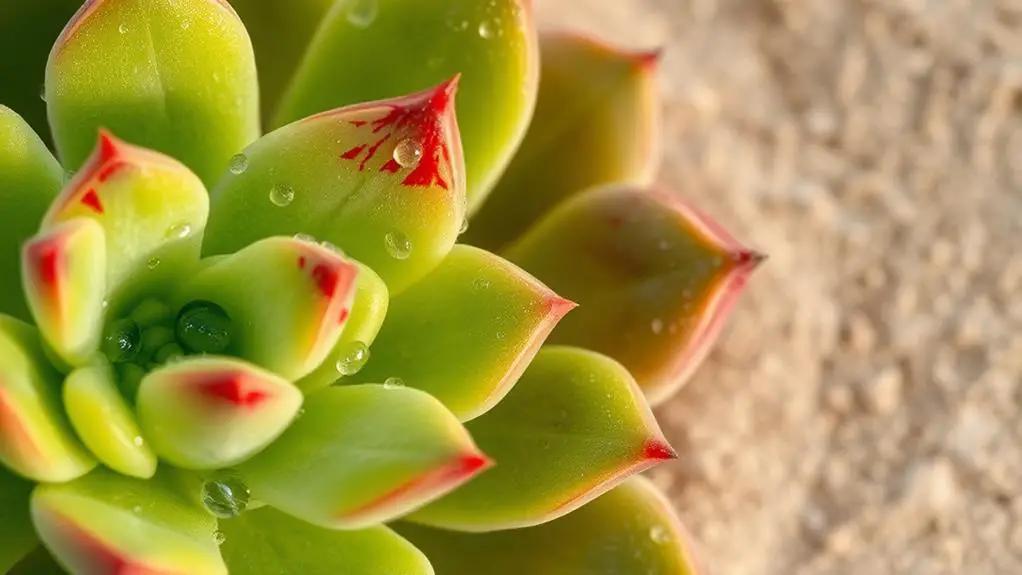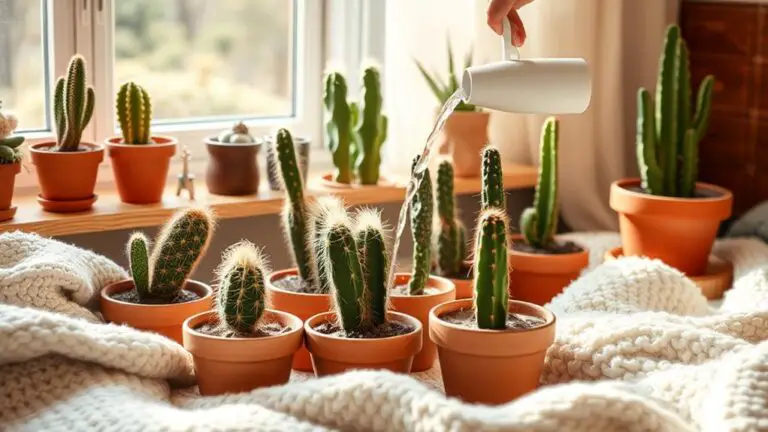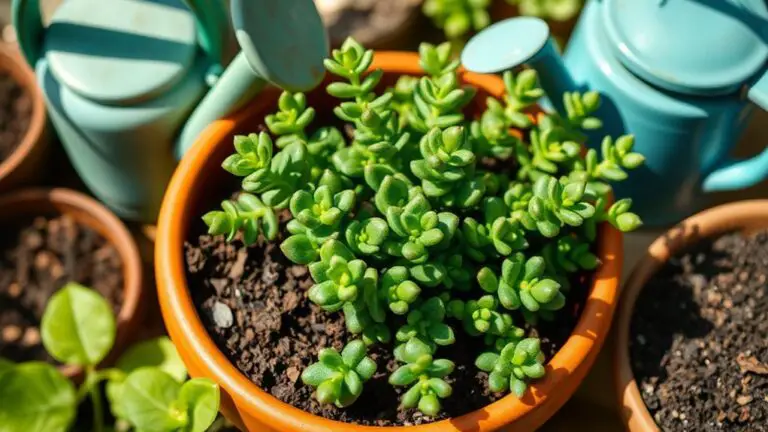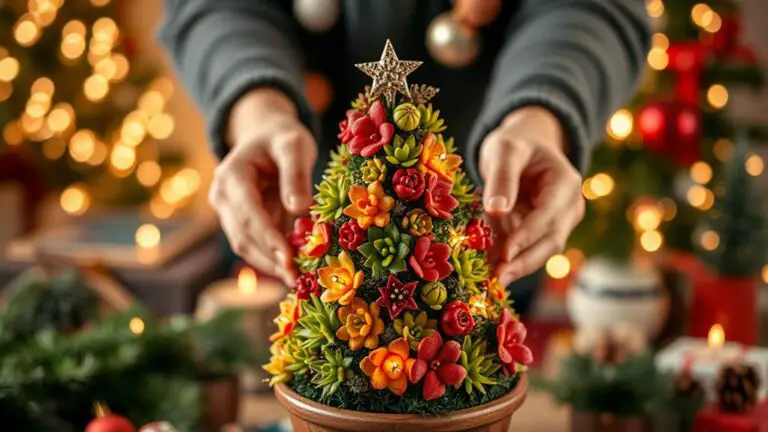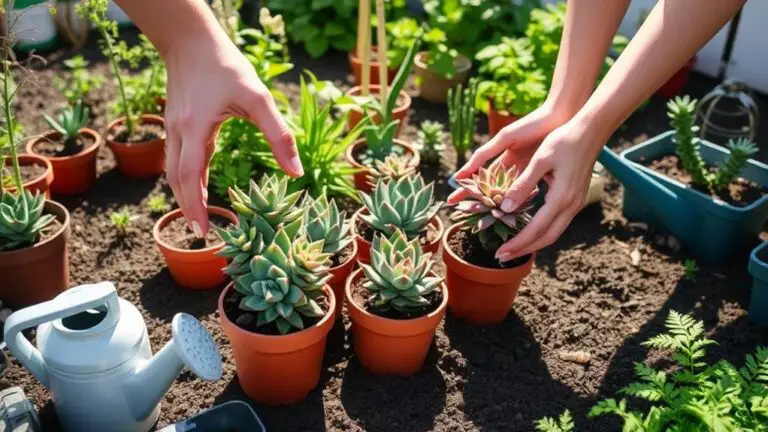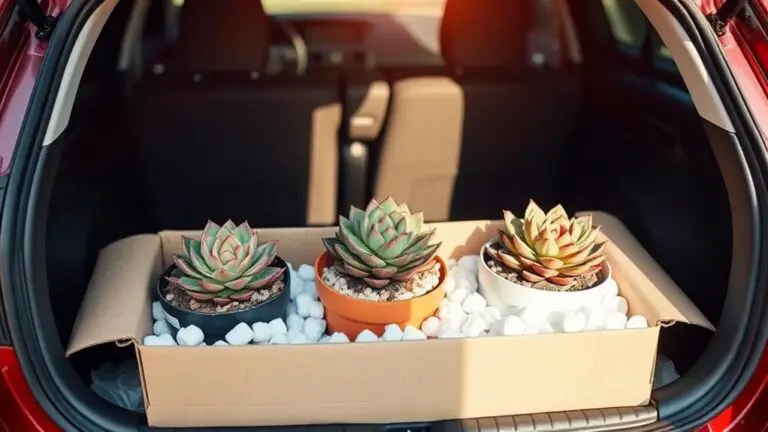How Succulents Heal Themselves: A Guide
When your succulent sustains an injury, it kicks into a fascinating self-healing process that showcases its resilience. Specialized cells form a callus at the wound site, acting as a protective barrier, while rapid cell division promotes new growth. These plants also produce essential chemicals to fend off infections and store water to maintain cellular functions. But that's just the surface. How do environmental factors like light and humidity impact this recovery? And what roles do meristematic cells and leaf drop play in healing? Understanding these elements can transform the way you care for your succulents.
Mechanisms of Self-Healing
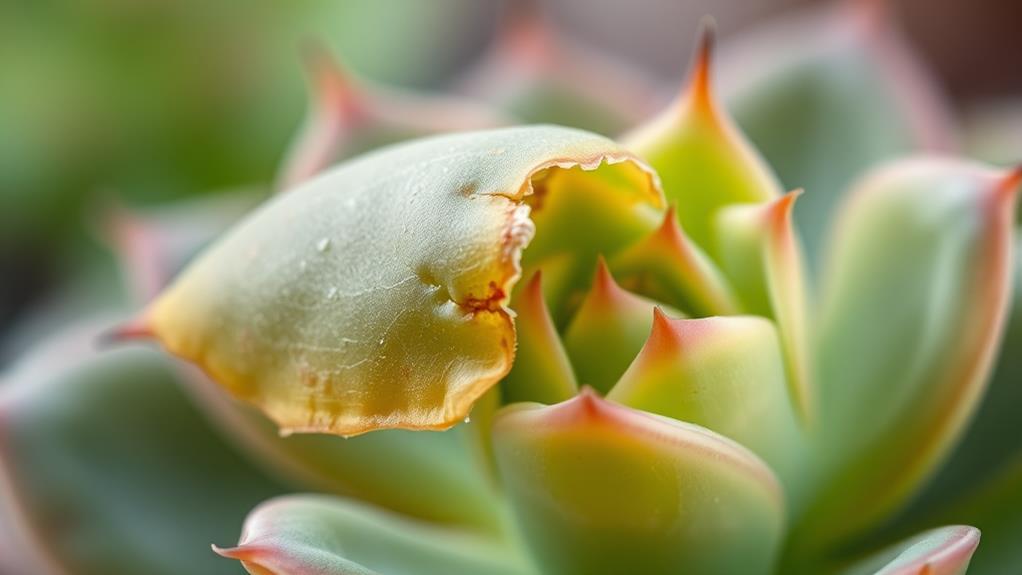
Succulents have developed fascinating self-repair mechanisms that guarantee their survival in harsh conditions. When your succulent gets injured, it immediately starts forming a callus at the wound site. This callus acts like a protective bandage, helping to seal the damaged area and prevent infections. It's the plant's way of shielding itself from further harm.
Meristematic cells come into play next. These special cells are like the body's natural repair team, driving tissue regeneration and the growth of new cells. They help the succulent heal by producing new tissues that replace the damaged ones. It's a bit like how your skin heals after a cut.
Water storage is another significant factor in a succulent's recovery. These plants store water in their leaves, stems, and roots, which helps maintain cellular functions during the healing process. This stored water is vital because it prevents the plant from dehydrating while it's repairing itself.
Lastly, if the environmental conditions are favorable, your succulent might even produce new leaves or shoots from the injured area. This ability showcases their incredible resilience and assures they can bounce back from injuries.
Chemical Responses to Injury
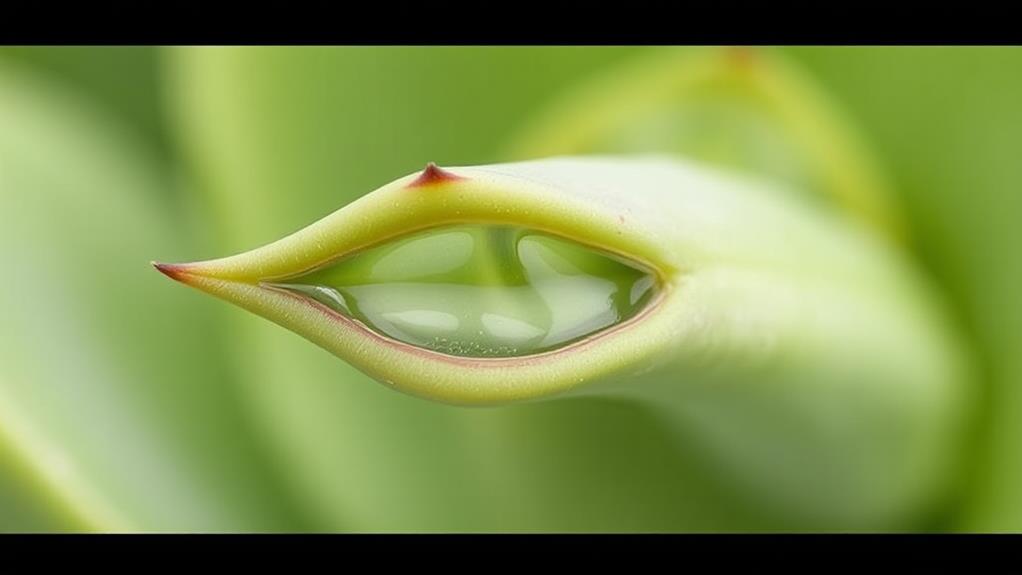
When succulents get injured, they quickly start making special chemicals and proteins to seal the wound and keep out harmful germs.
These plants also produce callus tissue to protect the damaged area while new cells grow to close it up.
With the help of phytohormones like auxins and cytokinins, succulents boost growth and cell division, speeding up the healing process.
Wound-Sealing Compounds
Imagine a tiny cut on a succulent's thick, fleshy leaf. You might wonder how the plant can heal itself. Succulents have a fascinating way of dealing with injuries using wound-sealing compounds. These compounds, such as proteins and phenolic compounds, help form a protective barrier that shields the plant from pathogens and environmental stressors.
When a succulent gets injured, its chemical responses kick in quickly. Here's what happens:
- Production of wound-sealing compounds: The plant creates special chemicals to seal the wound.
- Formation of a protective barrier: These chemicals form a layer that keeps out harmful agents.
- Callus formation: A callus forms at the injury site, acting as a scaffold for new growth.
- Internal water support: The succulent's water reserves help sustain cellular functions during healing.
These processes enhance the plant's resilience, making it strong enough to recover from wounds. The signals from the damaged tissue trigger these responses, ensuring the succulent can effectively protect and heal itself.
Regenerative Protein Production
As succulents work to seal their wounds with protective compounds, their next move involves a fascinating chemical response that ramps up regenerative protein production. When a succulent gets injured, it starts producing proteins and enzymes essential for healing and tissue regeneration. These regenerative proteins seal damaged areas, making it harder for pathogens to invade and helping new cells grow to repair the injury.
Phytohormones, like auxins and cytokinins, play a big role in this process. They regulate cell division and growth right at the injury site. As these hormones get to work, callus formation occurs quickly. A callus is a protective barrier that forms over the wound, allowing tissues to regenerate and new growth to happen without interruption.
In addition to proteins and hormones, succulents produce secondary metabolites, such as phenolic compounds. These compounds strengthen cell walls and boost pathogen resistance, making the healing process more effective.
Pathogen Defense Mechanisms
Upon injury, succulents launch an impressive chemical defense to ward off pathogens. They produce specific chemicals and proteins to seal damaged areas, preventing pathogen entry.
These plants also synthesize antimicrobial compounds that inhibit the growth of bacteria and fungi at the wound site. This response is essential for their protection.
Here's what happens when a succulent gets injured:
- Chemical Production: Succulents create phenolic compounds that strengthen their cell walls, adding an extra layer of protection.
- Antimicrobial Synthesis: They generate antimicrobial compounds to fight off bacteria and fungi.
- Defensive Metabolites Increase: There's a localized boost in defensive metabolites, enhancing the plant's ability to fend off potential infections.
- Callus Formation: Some succulents form a callus at the injury site, acting as a physical barrier to reduce pathogen invasion.
Understanding these processes helps you appreciate how resilient succulents are. By producing these defensive metabolites and strengthening their cell walls, they create a robust defense system.
The formation of a callus further guarantees their protection during recovery. Knowing this, you can see why succulents are such hardy and enduring plants.
Role of Callus Formation
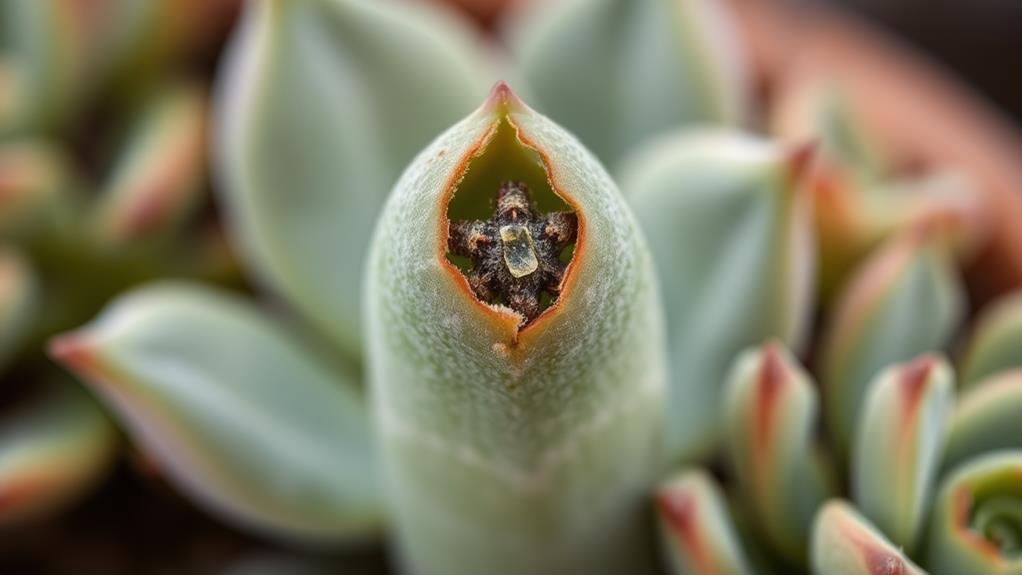
Callus formation kicks in as an essential defense mechanism when succulents face injury, creating a protective barrier against pathogens. When a succulent gets hurt, specialized meristematic cells at the wound site start to multiply. This rapid growth helps form a callus, a tough layer that not only seals the wound but also supports the healing process by transporting nutrients.
Understanding callus formation can help you care for injured succulents. With the right environmental conditions like humidity and temperature, succulents can recover swiftly from damage. This process is fascinating because it's the plant's way of defending itself and regrowing new structures.
Here's a quick guide to help you understand the factors influencing callus formation:
| Factor | Description | Importance to Healing |
|---|---|---|
| Humidity | Moist air needed for callus growth | Speeds up cell proliferation |
| Temperature | ideal warmth for cell activity | Promotes faster healing |
| Light Exposure | Sufficient light for energy | Aids in overall health |
| Nutrient Supply | Essential nutrients for growth | Supports tissue regeneration |
Water Storage and Cellular Function
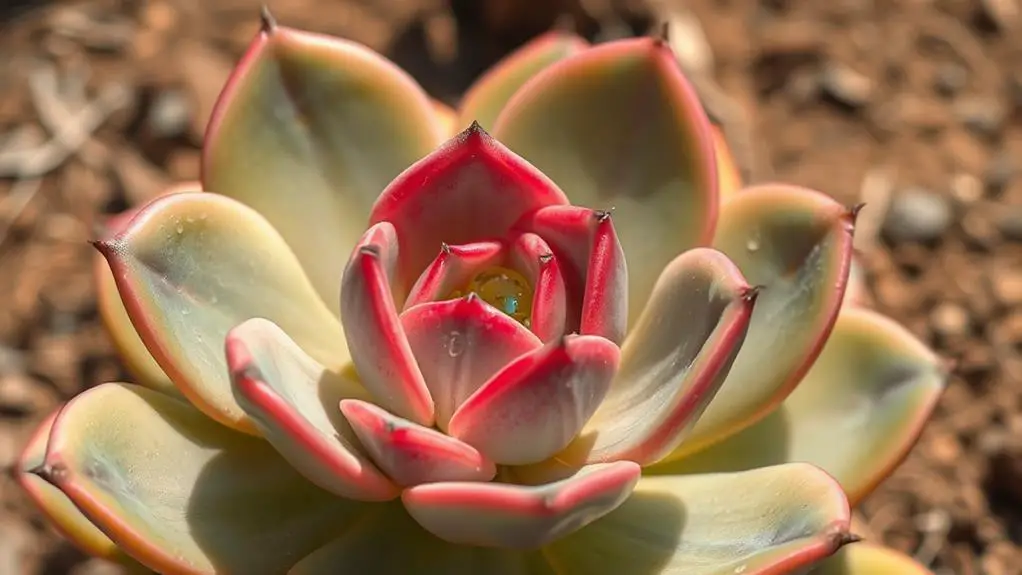
In understanding how succulents heal themselves, it's important to know how they store water to keep their cells functioning well.
Internal Water Reserves
Succulents' remarkable ability to store water in their fleshy leaves, stems, and roots is an important adaptation for surviving harsh environments.
These internal water reserves are essential for maintaining cellular function and supporting the healing process. When you look at a succulent, you're seeing a plant perfectly designed to thrive in arid environments.
Here's how it works:
- Storage Capacity: Succulents store water in specialized cells within their leaves, stems, and roots.
- Healing Power: During injury, they use this stored water to form calluses and support new growth.
- Hydration Maintenance: These water reserves keep the plant hydrated, preventing dehydration.
- Metabolic Support: The stored water is critical for metabolic processes, guaranteeing the plant stays healthy.
When a succulent gets damaged, it taps into these water reserves to aid in tissue repair and growth.
This ability to store water internally means succulents can bounce back from injuries and environmental stress.
By understanding how succulents use their internal water reserves, you can better appreciate their resilience and make certain they continue to thrive.
Cellular Hydration Mechanisms**
To truly appreciate how succulents heal themselves, it's imperative to explore their cellular hydration mechanisms. Succulents cleverly store water in their fleshy leaves, stems, and roots. This water storage is essential for maintaining cellular hydration and supporting their metabolic functions, especially during dry spells or when they're injured.
The internal water reserves in succulents allow them to keep functioning even when there's no external moisture. These reserves are like a built-in water tank, ensuring the plant can continue its cellular activities and stay alive. When a succulent gets hurt, it uses this stored water to fuel the healing process, which helps in regenerating damaged tissues.
Cellular hydration also plays a key role in maintaining turgor pressure. This pressure is what keeps the plant firm and upright, which is necessary for structural integrity and new growth after damage.
Specialized cells, such as meristematic cells, help manage water storage and use. These cells enable the succulent to adapt to different environmental conditions, ensuring it can survive and thrive.
Meristematic Cell Activity
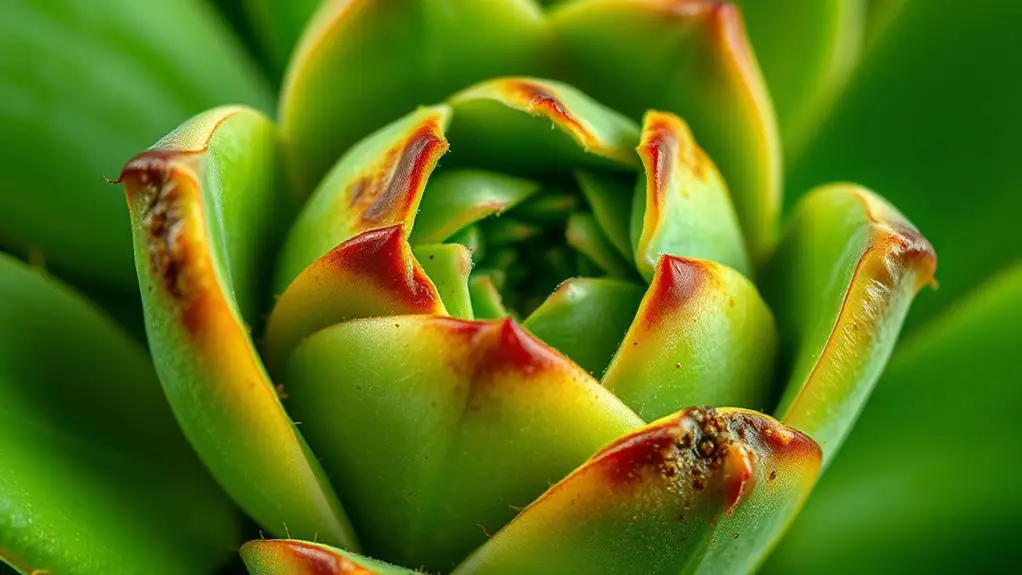
Meristematic cell activity plays a vital role in how succulents heal themselves. These undifferentiated cells, found in the growing regions like the tips of roots and shoots, are essential for producing new tissues in the healing process. When a succulent gets injured, meristematic cells quickly divide and transform into various types of cells, which helps regenerate damaged tissues and create new growth.
Here are some key points to understand about meristematic cell activity:
- Rapid Division: Meristematic cells can quickly multiply, forming a protective callus that seals wounds and keeps out harmful pathogens.
- Environmental Factors: Adequate moisture, light, and nutrients are vital. These factors stimulate meristematic cells, ensuring effective healing.
- Species-Specific: Different succulent species have varying abilities to regenerate. Some are naturally better at healing due to their adaptations.
- New Growth: The ultimate goal of meristematic cells is to produce new growth, ensuring the plant recovers and continues to thrive.
Common Succulent Injuries
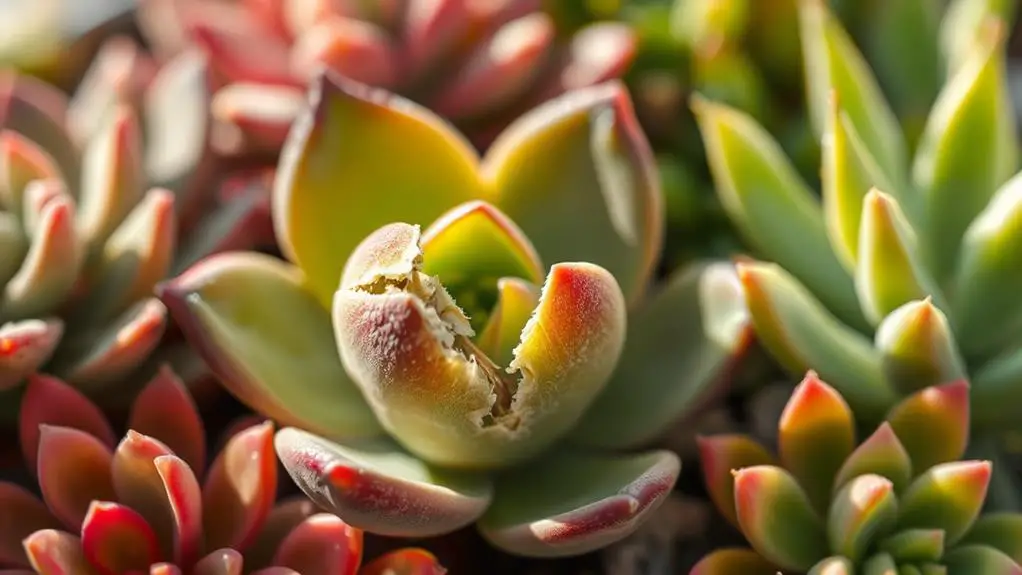
While meristematic cell activity is fundamental to a succulent's healing process, it's also important to understand the common injuries these resilient plants face.
One frequent issue is leaf drop, which can happen due to physical damage, environmental stress, or sudden changes in conditions. If you notice leaves falling off, carefully inspect your plant's environment and handling practices.
Sunburn is another common injury to succulents. When exposed to intense sunlight for too long, succulents can develop discolored or scarred patches on their leaves. To prevent sunburn, gradually acclimate your plant to increased sunlight and provide some shade during peak hours.
When a leaf breaks off, callus formation occurs at the injury site. This natural process seals the wound and keeps pathogens out, helping the plant to recover.
Curiously, fallen leaves can propagate, meaning they can grow into new plants under the right conditions. This turns potential losses into opportunities for growth.
Root rot, caused by overwatering or poor drainage, is a severe issue. It can lead to permanent tissue damage.
To manage this, make sure your succulent's soil drains well and let it dry out between waterings. With proper care, your succulent can thrive despite these challenges.
Leaf Drop and Recovery

Leaf drop in succulents can be alarming, but understanding the recovery process can help you manage and mitigate the issue effectively. When a succulent loses a leaf, it might be due to physical damage, stress, or changes in environmental conditions.
However, this isn't the end for your plant. Here's how you can help it recover:
- Monitor Water Levels: Make sure you're not overwatering or underwatering. Too much or too little water can exacerbate leaf drop.
- Check Environmental Conditions: Adequate light and proper temperature are essential. Make sure your succulent is in a suitable spot.
- Promote Callus Formation: Allow the broken leaf to form a callus. This seals the wound and prevents pathogen entry.
- Propagate Succulents: Fallen leaves can be used to grow new plants. Simply place them in a suitable environment to encourage root development.
Sunburn and Tissue Repair
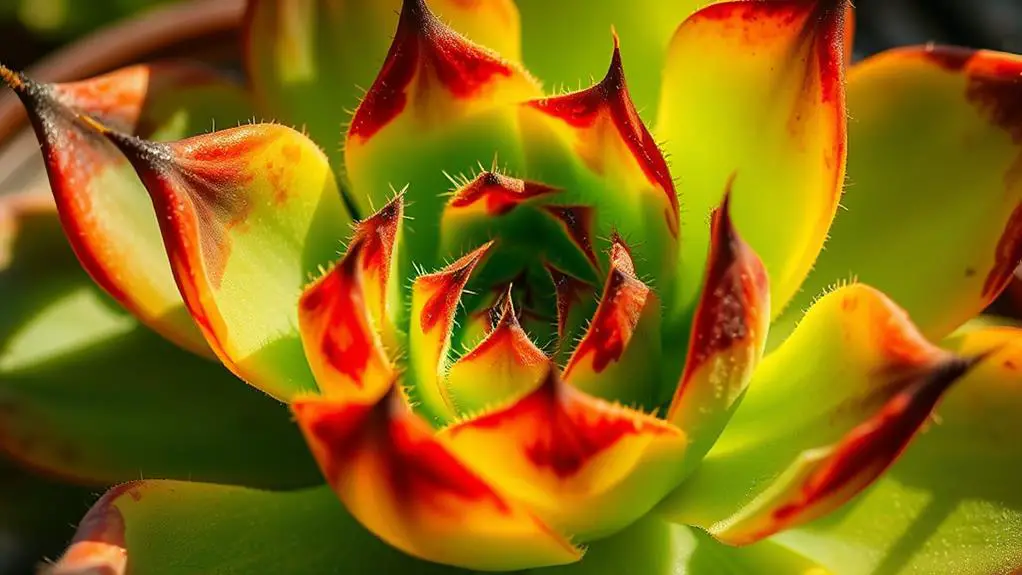
Noticing sunburn on your succulents?
Look for brown or reddish patches on the leaves, which mean they've had too much direct sunlight.
To help them heal, give them bright, indirect light and keep an eye on the light conditions to prevent further damage.
Recognizing Sunburn Symptoms
When succulents suffer from sunburn, discolored patches on the leaves, often browning or reddening, are clear indicators of tissue damage from too much sunlight.
These initial symptoms might also include wilting leaves and beige or brown spots. If left unattended, the damage can worsen, leading to severe tissue death.
To help your succulent recover, you should:
- Relocate it to a spot with bright indirect light: Direct sunlight can cause further harm. A shaded or filtered light area is ideal.
- Minimize watering: Overwatering can stress the plant further and may lead to rot. Keep the soil slightly dry.
- Regularly monitor the plant: Look for any new signs of sunburn or other stress signs. Early detection can make a big difference.
- Support healing: Remove severely damaged leaves to prevent infection and give the plant a better chance to recover.
Effective Healing Strategies
Although succulents can be resilient, effective healing strategies are important when they suffer from sunburn or tissue damage. Sunburn manifests as discolored patches, like browning or reddening, indicating damage that needs careful management.
To help your succulent heal, start by providing bright indirect light. This prevents further stress from harsh sunlight, allowing the plant to recover.
Pruning damaged or discolored leaves is essential. By removing these parts, you encourage your succulent to focus its energy on healthy growth and new tissue formation.
Pay attention to callus formation at the damaged site. This natural process creates a protective barrier, sealing the wound and preventing pathogen invasion.
Monitoring water levels is also crucial. Succulents rely on their internal water reserves during the healing period.
Make sure you're not overwatering them. Ensuring proper drainage helps prevent rot and supports recovery. Use a well-draining soil mix and pots with drainage holes.
Limitations of Self-Healing
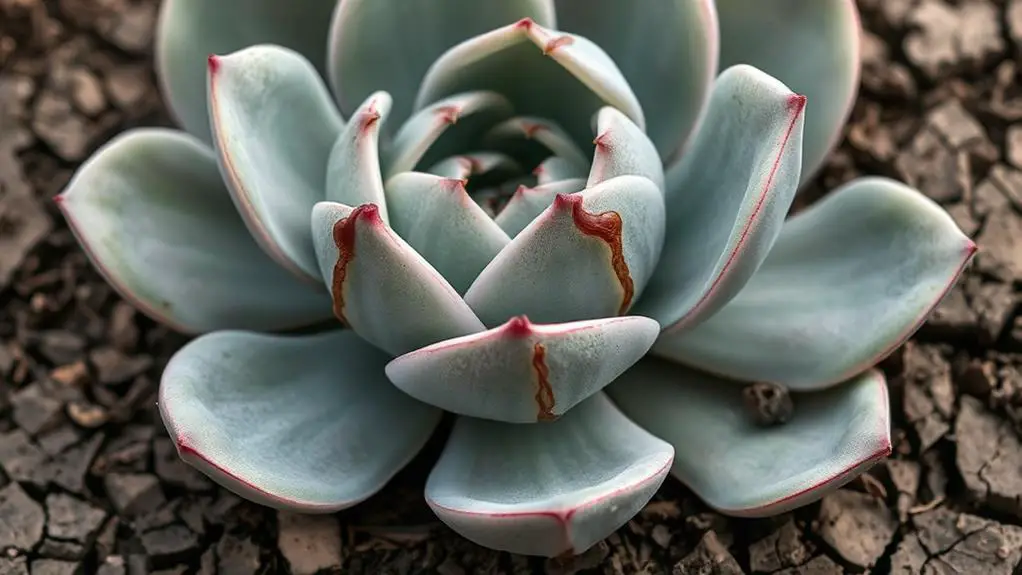
Succulents possess remarkable self-healing abilities, but these mechanisms have limitations. Permanent damage, such as burnt leaves, results in dry, brittle tissue that can't be reversed. Overwatering can cause rotting stems, which become soft and darkened, leading to irreversible damage. Etiolated stems, resulting from insufficient light, undergo structural changes that affect the plant's overall health and growth potential.
To manage these limitations, it's essential to recognize the extent of damage and act accordingly:
- Overwatering Damage: Prevent rot by guaranteeing proper drainage and only watering when the soil is dry.
- Trimming Damaged Tissue: Cut away dead or decaying parts to stop the spread of decay and encourage new growth.
- Fungal Infections: Use fungicides to manage infections that can further hinder recovery.
- Proper Care: Ensure adequate light and avoid extreme conditions to support overall plant health.
While succulents have impressive self-healing mechanisms, severe rot or extensive damage may require intervention.
By providing proper care and addressing issues promptly, you can help your succulents thrive despite their limitations.
Supporting Succulent Recovery
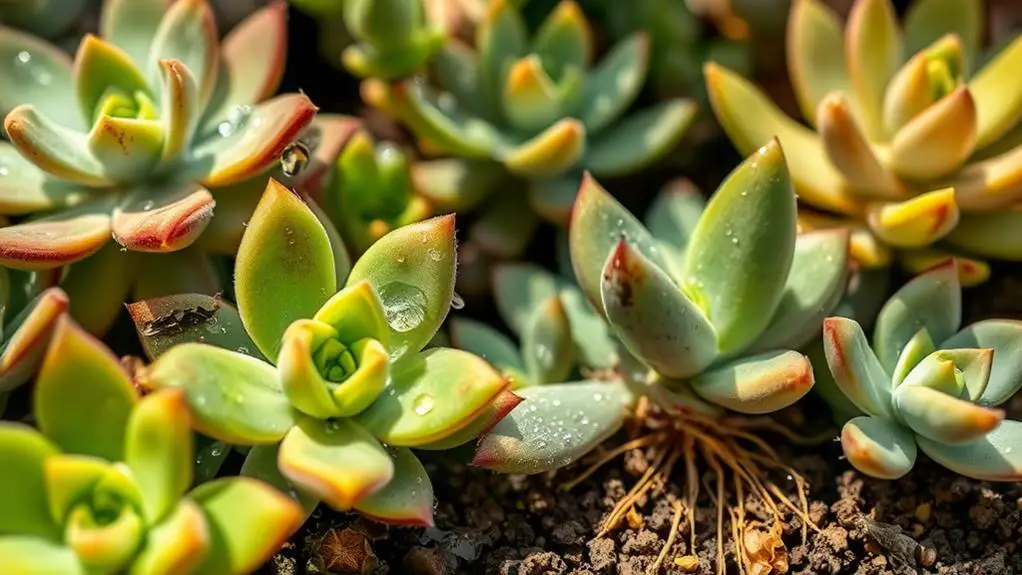
Supporting damaged succulents through recovery involves a few key steps that can make a significant difference.
First, you'll want to guarantee proper water management. Overwatering is a common issue, so always monitor water levels and allow the soil to dry out completely before watering again. This helps prevent rot and supports healing.
Next, place your succulents in bright, indirect light. This type of light promotes healthy growth without the risk of sunburn. Direct sunlight can be too harsh and may cause more damage.
Pruning is another essential step. Carefully trim away damaged areas to encourage your succulent to focus its energy on new growth. This not only improves the plant's appearance but also enhances the recovery process.
Understanding the specific needs of your succulent species is vital. Different succulents have unique requirements, so tailor your care tips accordingly. For example, some might need more frequent watering or specific soil types.
Lastly, always use well-draining soil to prevent water from pooling around the roots, which can cause further damage.
With these strategies, your succulents will have a much better chance of bouncing back and thriving. Remember, patience and attentive care go a long way.
Frequently Asked Questions
Do Succulents Repair Themselves?
Yes, succulents can repair themselves. They form calluses at injury sites and produce chemicals that stimulate tissue regeneration. Proper care, like monitoring water and light, is essential. Severe damage, though, might result in permanent tissue death.
How Do Succulents Protect Themselves?
You'll notice succulents protect themselves by forming a callus over wounds, producing protective chemicals, and utilizing internal water reserves. They also rely on meristematic cells to regenerate tissues, but can't heal severe burns or rot.
How Do You Heal Succulents?
You heal succulents by ensuring they have well-draining soil and ideal light. Detect issues early, and let wounds form calluses. Remove damaged parts carefully, and use fallen leaves to propagate new plants.
Should I Cut off Brown Leaves on Succulents?
Yes, you should cut off brown leaves on succulents. Doing so prevents rot, encourages new growth, and improves overall plant health. Use clean scissors to trim at the base, and let cuts callus before watering.
Conclusion
You've got this! By understanding how succulents heal, you can better support your plants. Keep an eye on their environment, ensuring they get the right light and humidity. Don't worry if they drop a leaf or get a sunburn; they have amazing self-healing powers. Provide water wisely and watch for new growth. With a bit of care, your succulents will thrive, recovering from injuries and growing stronger. Happy gardening!

